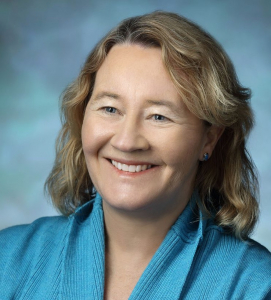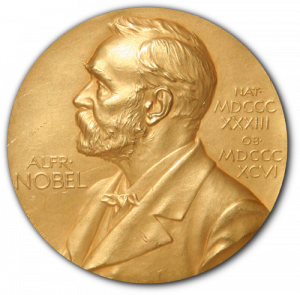 Dr. Carol Greider was folding laundry at home when she got the call in 2009 that she had won the Nobel Prize in Medicine. She decided to wake up her kids and tell them. “Do we have to go to school?”. “No you don’t,” she said, and she took them in to work with her later that morning.
Dr. Carol Greider was folding laundry at home when she got the call in 2009 that she had won the Nobel Prize in Medicine. She decided to wake up her kids and tell them. “Do we have to go to school?”. “No you don’t,” she said, and she took them in to work with her later that morning.
Although Carol was born in a family of scientists ( her dad was a physics professor and her mom was a PhD botanist), her mother died when she was only a first grader and she and her brother Mark (then a second grader), quickly had to learn to do things like getting themselves to school on their own.
About school, she wrote: “School was not easy for me. I was put in remedial spelling classes because I could not sound words out. I remember a special teacher coming into the classroom every week to take me out for special spelling lessons. I was very embarrassed to be singled out and removed from class. As a kid, I thought of myself as “stupid” because I needed remedial help. It was not until much later that I figured out that I was dyslexic and that my trouble with spelling and sounding out words did not mean I was stupid, but early impressions stuck with me and colored my world for a time….”
 Carol’s early schooling was complicated by having to attend a German school (along with her brother) when her father took a sabbatical in Germany. “I remember my grades were particularly poor in this school and especially so in the English class. The English teacher would give a dictation and we were supposed to write down what she said in English. It seemed too simple and pointless to me, but when I got my graded notebooks back, the scores were usually D’s or F’s because every other word was misspelled. Looking back over those notebooks later, I saw the pattern of backwards words and letters and gross misspellings that led me to suspect I was dyslexic. ”
Carol’s early schooling was complicated by having to attend a German school (along with her brother) when her father took a sabbatical in Germany. “I remember my grades were particularly poor in this school and especially so in the English class. The English teacher would give a dictation and we were supposed to write down what she said in English. It seemed too simple and pointless to me, but when I got my graded notebooks back, the scores were usually D’s or F’s because every other word was misspelled. Looking back over those notebooks later, I saw the pattern of backwards words and letters and gross misspellings that led me to suspect I was dyslexic. ”
By the time Carol left Germany, she could speak and read German fairly well, but writing and spelling remained a challenge. Carol had some challenges transitioning back to US schools, but because she could memorize words in order to spell them (rather than sounding them out), she found she could succeed in school (N.B. from Fernette: Carol would probably be considered a “stealth dyslexic.”)
By the time Carol finished high school, she had begun to think about a career in Biology. Most of her friends planned to go to nearby colleges like UC Davis or UC Berkeley, but Carol “did not want to go to either. I wanted to do something different from the norm, get out and have new experiences.”
Her father put her in contact with a biology professor (Beatrice Sweeney, or ‘Beazy’ for short) at The College of Creative Studies in Santa Barbara who had known her mother. “She took us for a walk on the beach near her house and told us fascinating stories about the biology of all the marine animals and plants that we walked by. I was captivated by her and by the beautiful UCSB campus. I decided I wanted to study Marine Ecology at UCSB.”
Later Carol would say that the most important thing she learned from Beazy was that she should start working in a lab right away. That turned out to be a great move because she loved working in a lab. The first lab she worked in didn’t capture her attention because it was filled with statistics which she couldn’t understand or relate to. Beazy suggested a different lab working with a microorganism.
“I enjoyed the work in the lab. I liked coming in to do my own experiments and was challenged when Beazy said I had to come up with a way to plot and describe my experiment on my own, with no set form. The simultaneous pain and joy of trying to create something that made sense to describe my observations was exhilarating.” But even after this experience, Carol wanted to do more experimentation rather than work that seemed more observational and descriptive.
 The third lab Carol worked at was definitely more fun and the work gave her experience with molecular biology. But most of all, Carol later reflected, she found that her choice of a lab was the best when it combined fun people to work with and interesting science.
The third lab Carol worked at was definitely more fun and the work gave her experience with molecular biology. But most of all, Carol later reflected, she found that her choice of a lab was the best when it combined fun people to work with and interesting science.
Carol’s Nobel prize winning work would come together at UC Berkeley when she worked with Dr. Elizabeth Blackburn. They remain good friends today.
Looking back on her education, Carol admitted getting low scores on both her SAT and GRE for grad school. “I got many rejection letters. However, two schools did decide to interview me. ” She had many A’s and lots of lab experience but poor GRE scores. This is another reason why Carol is such a vocal advocate for having universities see beyond test scores:
“If U.C. Berkeley had done the same thing that many of the other schools did, which was to apply a cutoff, then I wouldn’t have gone to graduate school and made the discovery of telomerase and won the Nobel Prize.”
Carol also often speaks out on the importance of “discoveries driven by pure curiosity. We had no idea when we started this work that telomerase would be involved in cancer, but were simply curious about how chromosomes stayed intact. What intrigues basic scientists like me is that any time we do a series of experiments, there are going to be three or four new questions that come up when you think you’ve answered one. Our approach shows that while you can do research that tries to answer specific questions about a disease, you can also just follow your nose.” She also added, “Perhaps my ability to pull more information out of context and put together difficult ideas may have been affected by what I learned to do from dyslexia.”
How interesting that Dr. Greider, like so many accomplished people with dyslexia shared the importance of curiosity in driving their most important work. Perhaps that’s one of the most important ingredients in harnessing the power of the Dyslexic Mind.














